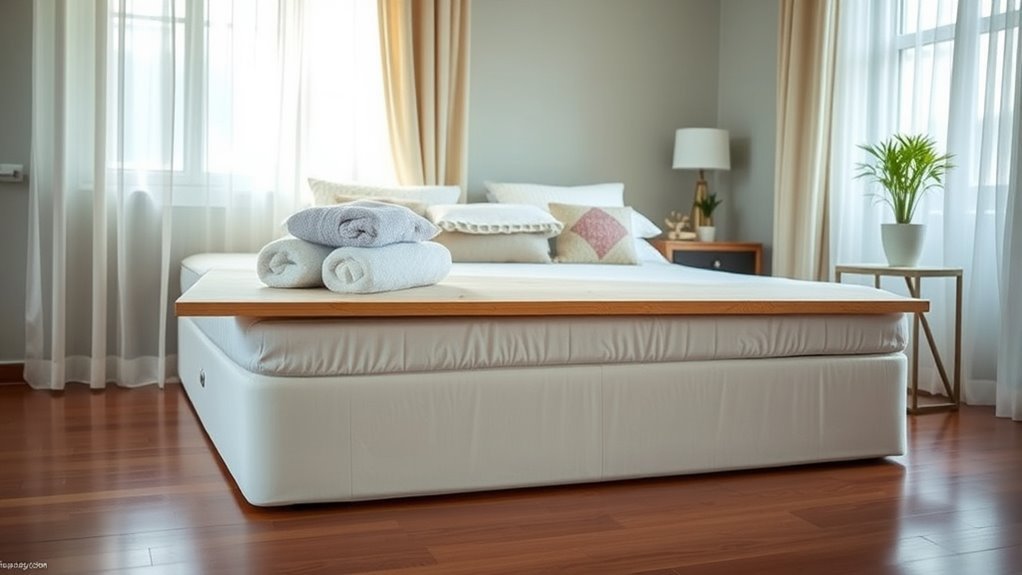To fix a sagging mattress without buying a new one, start by rotating it every three to six months for even wear. Consider adding a mattress topper for extra comfort and support. Placing plywood under the mattress can also enhance stability. Check your box spring and bed frame for damage, and use pillows strategically for better alignment. If needed, try a firmness adjuster for customized support. There’s plenty more to explore for a better night’s sleep.
Rotate Your Mattress Regularly

Although it might seem like a small detail, rotating your mattress regularly can greatly extend its lifespan and improve your sleep quality. By establishing a rotation schedule—ideally every three to six months—you help guarantee even wear and reduce the risk of sagging. This simple act is a key aspect of mattress maintenance that many overlook. When you switch the head and foot of your mattress, you distribute weight more evenly, allowing it to regain its shape and support. Plus, it can enhance your comfort, making those peaceful nights more attainable. So, take the time to incorporate this practice into your routine. Your future self will thank you for the freedom of a well-maintained mattress that supports restful sleep.
Use a Mattress Topper

If your mattress is sagging, a mattress topper can be a game changer. There are various types available, each offering unique benefits that can enhance your sleep quality. Understanding how to choose the right one for your needs can make all the difference in restoring comfort to your bed.
Types of Mattress Toppers
When your mattress starts to sag, adding a mattress topper can be a game-changer, as it provides an extra layer of comfort and support. There are several types of toppers to evaluate. Memory foam toppers conform to your body, relieving pressure points and enhancing support, perfect if you like a cozy feel. On the other hand, latex options offer a more responsive surface, promoting airflow and keeping you cooler throughout the night. If you’re looking for a more eco-friendly choice, natural latex is durable and hypoallergenic. When choosing a topper, think about your sleeping style and preferences to find the right balance of comfort and support. Embrace the freedom to customize your sleep experience without breaking the bank!
Benefits of Using Toppers
Adding a mattress topper not only enhances comfort but also offers a range of benefits that can greatly improve your sleep quality. Here are some key advantages of using a topper:
- Improved Support: Toppers provide extra cushioning, helping to alleviate pressure points and support your body better.
- Enhanced Mattress Longevity: By protecting your mattress from wear and tear, a topper can extend its lifespan, saving you money in the long run.
- Temperature Regulation: Many toppers are designed to wick away moisture and regulate temperature, ensuring you stay comfortable throughout the night.
- Customizable Comfort: You can choose a topper that fits your sleep style, allowing you to tailor your sleeping experience to your needs.
With these benefits, a mattress topper can truly elevate your sleep experience!
How to Choose One
Choosing the right mattress topper can greatly enhance your sleep experience, especially if your mattress has started to sag. First, consider your comfort preferences. Do you like a plush feel or prefer firmer support? Memory foam toppers offer contouring support, while latex provides a bounce and cooler sleep. Next, think about mattress firmness; if your mattress is too soft, a firmer topper can help. If it’s too firm, a softer option can add comfort. Look for toppers with good durability; high-density foam or quality latex usually lasts longer. Finally, check reviews and ratings to guarantee you’re making a sound investment. By carefully selecting a topper, you can rejuvenate your sleep without the cost of a new mattress.
Add Support With Plywood

If your mattress has started to sag, one effective solution is to add support with plywood. This simple addition can greatly enhance your sleep experience. Here’s how to do it:
- Choose the Right Plywood: Opt for a ¾-inch thick piece of plywood that fits your mattress size.
- Prepare for Plywood Placement: Clear your bed frame and make sure it’s clean and sturdy.
- Position the Plywood: Lay the plywood directly on the box spring or slats, confirming it’s centered.
- Test for Comfort: Lie down to feel the support enhancement. Adjust if necessary for best comfort.
Check the Box Spring or Bed Frame
Before jumping to conclusions about your sagging mattress, it’s essential to check the box spring or bed frame for any damage. Look for cracks or broken slats that might be compromising support, and consider adjusting the support level if needed. If you find worn components, replacing them could make a significant difference in your mattress’s overall feel and longevity.
Inspect for Damage
A thorough inspection of your box spring or bed frame is essential when addressing a sagging mattress. Performing a mattress inspection helps identify any potential issues that could be contributing to the sag. Here’s how to conduct a damage assessment:
- Check for Broken Slats: Look for any cracks or breaks in the slats that support your mattress.
- Examine the Box Spring: Verify the box spring is intact without sagging or damage.
- Inspect the Bed Frame: Look for any loose screws or faulty joints that may compromise support.
- Assess Overall Stability: Make certain the entire frame feels sturdy and doesn’t wobble or creak.
Adjust Support Level
After inspecting for damage, the next step in addressing a sagging mattress is to adjust the support level provided by your box spring or bed frame. Start by checking if your box spring is intact; a broken or worn-out box spring can lead to sagging. If you’re using an adjustable bed, verify it’s functioning properly, as a malfunction might affect mattress firmness. Consider adding a plywood board between the mattress and the frame for extra support. This simple fix can help distribute weight more evenly and reduce sagging. Remember, a supportive base is vital for maintaining the integrity of your mattress, giving you the restful sleep you deserve without the need for a new purchase.
Replace Worn Components
Over time, components like your box spring or bed frame can wear out, contributing to that annoying sag in your mattress. Regularly checking these parts is essential for maintaining your mattress’s support and comfort. Consider these points to guarantee your setup is solid:
- Inspect the Box Spring: Look for cracks or broken slats; they can compromise support.
- Check the Bed Frame: Confirm it’s sturdy and free from any wobbling or bending.
- Replace Worn Out Materials: If your box spring or frame is made from low-quality mattress materials, it might be time for an upgrade.
- Know Component Lifespan: Typically, box springs last around 10 years, so keep track of their age.
Taking these steps can greatly enhance your sleep experience!
Try a Mattress Firmness Adjuster
If you’re finding your mattress lacks the support it once had, consider using a mattress firmness adjuster. These handy tools allow you to customize your sleep experience by enhancing mattress firmness where you need it most. With adjustable features, you can easily modify the level of support to suit your body type and sleeping position. Whether it’s a simple foam layer or an air-filled insert, these adjustments can make a significant difference in comfort. Not only do they help alleviate pressure points, but they also prolong the life of your mattress. By taking this step, you can reclaim the restful sleep you deserve without the hassle of shopping for a new mattress. Enjoy the freedom of personalized comfort!
Repair or Replace Worn-out Components
Even with a mattress firmness adjuster, you might still find that your mattress isn’t providing the support you need. It could be time to repair or replace worn-out components. Here’s how to tackle the issue:
- Inspect the Springs: Check for worn out springs. If they’re damaged, replacing them can restore your mattress’s support.
- Replace the Mattress Cover: A fresh mattress cover can improve comfort and protect against wear.
- Add a Plywood Board: Placing a board under the mattress can provide additional support where it’s sagging.
- Consider a Mattress Pad: A thick pad can help even out the surface and prolong the mattress’s life.
Taking these steps can breathe new life into your mattress without emptying your wallet.
Use Pillows for Extra Support
One simple yet effective way to enhance the support of your sagging mattress is by using pillows strategically. By adjusting pillow placement, you can create the right support angles for your body, alleviating discomfort. For instance, if your mattress dips in the center, try placing a firm pillow under your lower back to fill the gap. If you sleep on your side, positioning a pillow between your knees can help keep your spine aligned. Experiment with different heights and firmness levels to find what feels best for you. This approach not only prolongs the life of your mattress but also allows you to enjoy a more restful night’s sleep without the need for a costly replacement.
Maintain Proper Cleaning and Care
While you might not think about it often, maintaining proper cleaning and care for your mattress can greatly impact its longevity and comfort. By adopting effective cleaning techniques and staying on top of mattress maintenance, you can guarantee your bed remains a sanctuary. Here are some tips to help you:
- Vacuum regularly: Remove dust, allergens, and debris to keep your mattress fresh.
- Spot clean stains: Use mild detergent and water immediately on spills to prevent permanent marks.
- Rotate your mattress: Flip or rotate it every few months to promote even wear.
- Use a mattress protector: This shields against spills and dust mites, extending your mattress’s life.
Frequently Asked Questions
How Often Should I Rotate My Mattress for Best Results?
You should rotate your mattress every three to six months for the best results. This practice is key to mattress maintenance, helping to even out wear and prolong its lifespan. By rotating it regularly, you can enhance your sleep quality, ensuring you don’t develop uncomfortable sagging in specific areas. Just flip it over or switch the head and foot positions to promote balance and comfort in your sleeping experience.
Can a Mattress Topper Completely Fix Sagging?
A mattress topper can greatly improve sagging, but it won’t completely fix the issue. If you’re looking to restore some mattress firmness, choosing a thicker topper—around 3 inches or more—can provide better support. However, keep in mind that while it helps, it’s not a permanent solution. Regularly rotating your mattress and investing in a quality topper can extend its life and enhance your sleeping experience, giving you the freedom to enjoy restful nights.
What Type of Plywood Should I Use for Support?
For fantastic firmness, you’ll want to choose a sturdy plywood type. A ¾-inch thickness is ideal, providing solid support without compromising comfort. Plywood types like birch or maple offer durability and strength. They can help eliminate unwanted dips in your mattress. Just cut the plywood to fit your bed frame, ensuring it’s well-supported beneath the mattress. This simple solution enhances your sleep experience, giving you the freedom to rest soundly each night.
How Can I Tell if My Box Spring Is Damaged?
To tell if your box spring’s damaged, start with a thorough box spring inspection. Look for any cracks, broken slats, or uneven surfaces. If you notice sagging or noticeable dips, that’s a clear sign of damage. Listen for creaking noises when you move; these sounds often indicate instability. Also, check for any loose joints or fasteners. If any signs of damage are present, it might be time to contemplate a replacement.
Are There Specific Pillows Recommended for Extra Support?
For extra support, consider using memory foam or latex pillows, as they contour to your neck and head, providing excellent support levels. If you prefer a firmer feel, try a buckwheat or gel-filled pillow. These pillow types can help align your spine and reduce pressure on your shoulders and hips. Ultimately, it’s about finding the right balance of comfort and support that suits your unique sleeping style and preferences.



